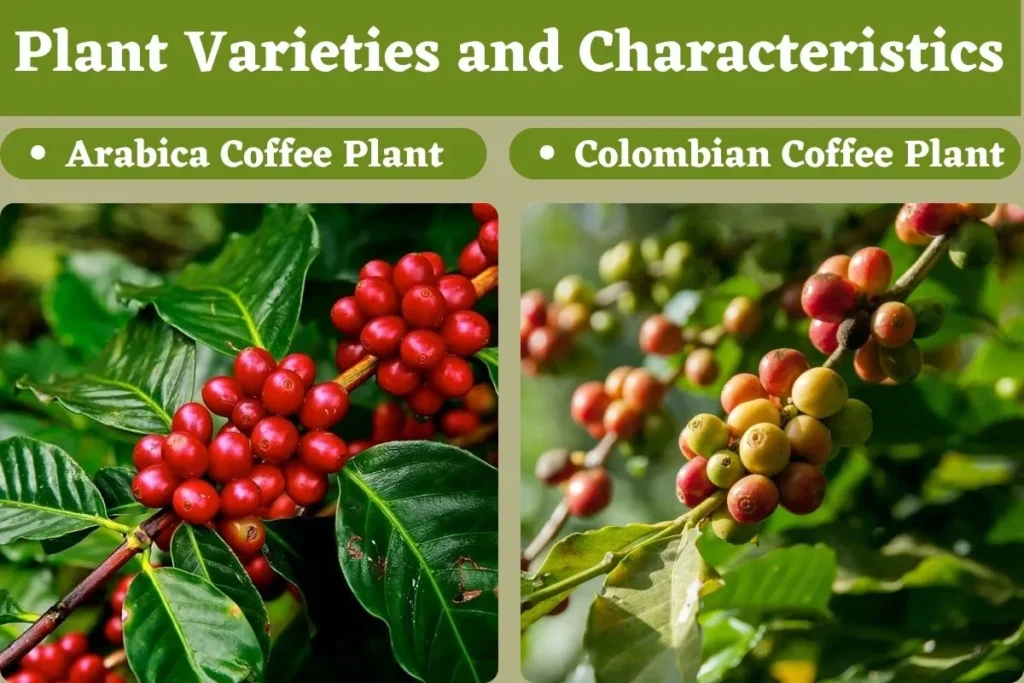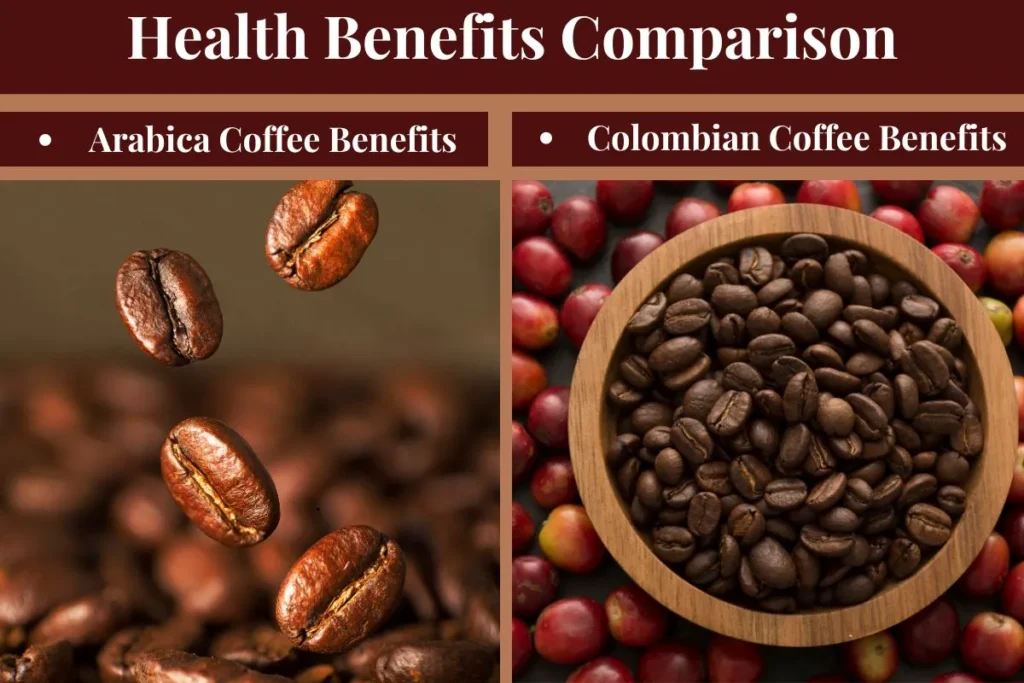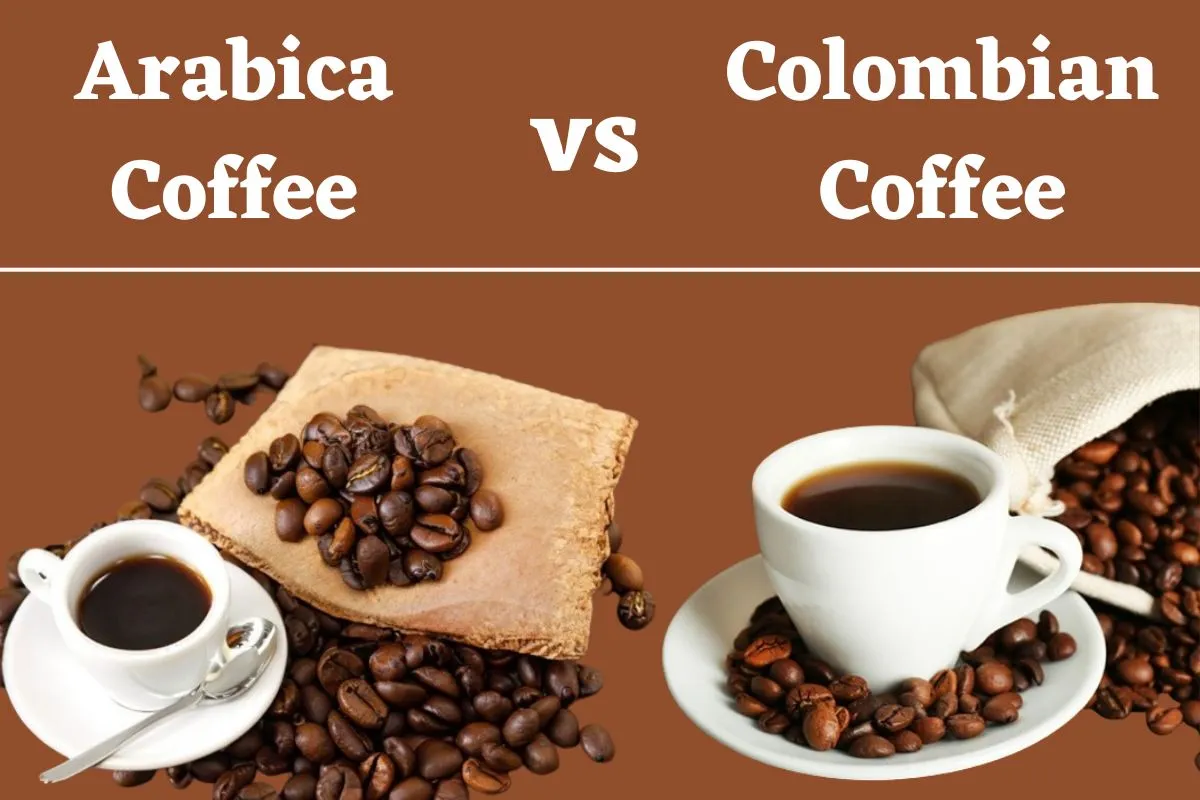When it comes to the world of coffee, two names stand out: Arabica Coffee vs Colombian Coffee. These two varieties have captured the hearts of coffee enthusiasts worldwide with their unique flavors, rich histories, and cultural significance.
In this article, we’ll delve into the differences between Arabica Coffee vs Colombian Coffee, exploring their origins, flavor profiles, growing conditions, and much more.
Knowing the differences between these two popular brews will enhance your appreciation of the rich and varied world of coffee, regardless of your experience level or level of interest in specialty coffee.
Arabica Coffee vs Colombian Coffee: Origins and Background
Arabica Coffee
The history of Arabica coffee is lengthy and illustrious, spanning several centuries. Arabica coffee is thought to be the original kind of coffee ever grown, and it comes from the lush highlands of Ethiopia.
Legend has it that the first person to notice the stimulating benefits of coffee was a goat herder by the name of Kaldi, who saw that his goats become exceptionally lively after eating the red berries from a certain tree.
The local monks were intrigued by Kaldi’s discovery and started experimenting with the berries to make a drink that would keep them awake during lengthy periods of prayer and meditation.
Arabica coffee, prized for its sophisticated flavor and energizing aroma, is still one of the most popular and extensively consumed drinks in the world today.
Colombian Coffee
Colombian coffee has a history that is just as colorful and rich as the nation. The history of Colombian coffee dates back to the 18th century, when coffee was first grown in the country’s hilly regions by Jesuit monks.
Blessed with fertile soil, ample rainfall, and ideal growing conditions, Colombia quickly emerged as one of the world’s premier coffee-producing regions.
Today, Colombian Coffee is celebrated for its exceptional quality, distinctive flavor profile, and unparalleled consistency. From the bustling streets of Bogotá to the lush coffee plantations of the Andes Mountains, coffee remains an integral part of Colombian culture and heritage.
Plant Varieties and Characteristics

While from the same Arabica species, the specific growing conditions and processing methods in Colombia result in the Colombian coffee having a smoother, milder flavor profile compared to general Arabica coffees from other origins. The higher elevation is a key factor giving Colombian beans their distinct characteristics.
Arabica Coffee Plant
The Arabica coffee plant, known scientifically as Coffea arabica, is renowned for producing high-quality beans with complex and nuanced flavor profiles. This species thrives in high-elevation regions, typically between 500 and 2,000 meters above sea level, where rich volcanic soil provides an ideal growing environment.
The Arabica plant itself features slender branches adorned with oval-shaped leaves and small white flowers. Each cherry produced by the plant contains two beans, which are carefully processed to extract the flavorful arabica coffee we know and love.
Notably, Arabica coffee is celebrated for its relatively low caffeine content when compared to other coffee varieties, such as Robusta.
Colombian Coffee Plant
Colombian coffee refers specifically to Arabica coffee plants cultivated within the geographic boundaries of Colombia.
While genetically similar to other Arabica plants, the coffee grown in Colombia exhibits distinct characteristics due to the unique environmental factors present in the country’s coffee-growing regions.
Colombian coffee is typically grown at higher elevations, ranging from 1,200 to 1,800 meters above sea level, compared to other Arabica varieties. The diverse climate, soil conditions, and elevation contribute to the development of a smoother, richer taste with less acidity than other Arabica coffees.
This can be partly attributed to an extra washing step employed during the processing of Colombian coffee beans, a labor-intensive method that further enhances the flavor profile. As a result, Colombian coffee is often regarded as a premium-quality offering within the Arabica coffee family.
Growing Conditions
Climate and Elevation Requirements
Arabica coffee plants thrive in climates found at higher elevations, typically between 1,200 and 2,200 meters above sea level. The optimal temperature range for their growth lies between 15 and 24 degrees Celsius (59 to 75 degrees Fahrenheit).
Consistent rainfall and specific humidity levels are essential requirements for the plants to flourish. The Ethiopian highlands and the Andean mountain ranges in Colombia provide these ideal elevation conditions for cultivating Arabica coffee.
Soil Preferences
Arabica coffee plants prefer to grow in rich, nutrient-dense volcanic soil. The volcanic soil found in the coffee-growing regions of Ethiopia and Colombia contributes significantly to the desirable flavors of the beans.
Well-drained soils are crucial for the healthy growth of Arabica plants, ensuring proper root development and overall plant vigor.
Processing Methods
Wet Processing
Wet processing, also known as washed processing, is a popular method used for processing Colombian coffee beans. This method involves the removal of the pulp from the coffee cherries after they are picked. The cherries are mashed using a specialized machine called a pulper to accomplish this.
Following this step, the mashed beans are allowed to dry. To ensure a thorough and consistent drying process, the beans are washed with water, which helps remove any remaining pulp. Colombian coffee that undergoes wet processing is sometimes referred to as ‘washed Arabica’.
Dry Processing
Dry processing is a method where the coffee cherries are allowed to dry in their entirety, with the skin and pulp still intact. Once the cherries are sufficiently dry, they are hulled, a process that removes the outer layer of the bean, including the pulp and skin.
This method is more commonly used for processing Arabica coffee beans that are not specifically grown in Colombia. Dry-processed beans often have a more robust and earthy flavor profile as compared to their wet-processed counterparts.
Flavor Profiles and Aromas
Arabica Coffee Taste
Arabica coffee is known for its diverse range of flavors, often described as complex and nuanced. The taste profile of Arabica beans typically includes a mild acidity, which adds a pleasant brightness to the overall flavor. The acidity levels can vary, but they tend to be less prominent than those found in Robusta beans.
The flavor of Arabica coffee often features notes of vanilla, caramel, and chocolate, adding a richness and depth to the brewed drink.
Fruit flavors, such as apple, berries, and citrus, can also be detected, giving the coffee a refreshing, vibrant quality. Aromatic spices like cinnamon and cocoa may be present as well, enhancing the complexity of the taste.
Colombian Coffee Taste
As a specific type of Arabica coffee, Colombian coffee has its own unique set of characteristics that distinguish it from other Arabica varieties. Grown exclusively in the nation of Colombia at elevations between 1,200 meters to 1,800 meters above sea level, these beans benefit from the region’s distinct soil, climate, and processing methods.
Colombian coffee is recognized for its smooth, well-rounded flavor profile, making it a popular choice for coffee enthusiasts seeking a milder option. The taste of Colombian coffee generally features a balanced acidity, creating a pleasing brightness without overwhelming the palate.
In terms of flavor, Colombian coffee shares some similarities with general Arabica beans, such as notes of caramel and cocoa. However, the unique soil and elevation contribute to additional fruity flavors, like green apple, apricot, and peach. The aroma of Colombian coffee is often described as rich and floral, with hints of citrus fruit and toasted nuts.
Roasting and Brewing
Roasting Arabica and Colombian Coffee Beans
Arabica and Colombian coffee beans are both types of Arabica beans, but Colombian beans have unique properties due to their growing conditions and processing methods. When roasting these beans, it is essential to consider their characteristics to achieve the desired flavor profile.
Arabica beans are known for their dark, thick flavors, while Colombian beans offer a lighter, fruitier taste. Both types require different roasting techniques to highlight their unique flavors.
For Arabica beans, a medium to dark roast is recommended to bring out the full body and bold taste notes. On the other hand, Colombian beans should be roasted to a lighter degree, preserving the delicate fruity and floral notes.
Brewing Arabica vs Colombian Coffee
The brewing process plays a significant role in extracting the unique flavors of Arabica and Colombian coffee. Espresso, Aeropress, and other brewing methods can be employed to produce a satisfying cup of coffee with both bean types.
For Arabica coffee, an espresso machine works best to extract the bold, dark flavors that this bean is known for. The pressure and temperature provided by an espresso machine bring out the full potential of Arabica beans, resulting in a rich and robust coffee.
In contrast, Colombian coffee benefits from gentler brewing processes such as Aeropress, pour-over, or drip coffee makers. These methods allow for a slower extraction, which can emphasize the fruity and floral nuances present in Colombian beans.
Additionally, these brewing processes typically require a lower temperature, which further preserves the delicate flavors of Colombian coffee.
Pricing and Quality
Factors Affecting Prices
When discussing Arabica and Colombian coffee, it’s essential to understand the distinctions in quality and price that set them apart. Arabica coffee, a variety of the coffee plant, is known for its high-quality beans, which typically result in a more robust and acidic taste with a subtle earthy flavor.
Colombian coffee is unique due to the specific environmental factors in the country, including elevation levels, soil types, and climate. Colombian coffee beans are usually grown on slopes between 1,200 meters to 1,800 meters above sea level, which affects the beans’ flavor profile.
Factors such as growing region, bean variety, processing methods, and brand reputation all contribute to the final price point of both Arabica and Colombian coffees.
Quality Differences
In general, both Arabica and Colombian coffees can be found in various quality and pricing tiers, including affordable blends and premium single-origin batches.
However, it is essential to note that higher price doesn’t always guarantee better quality, and personal preferences play a significant role in determining the best coffee selection for each individual.
When comparing prices of Arabica and Colombian coffees, it is crucial to consider that Colombian coffee is predominantly of the Arabica variety and is only grown within Colombia, which can impact its price range due to this exclusivity.
Health Benefits Comparison

Arabica Coffee Benefits
Arabica coffee is more than simply a tasty beverage because it has several health advantages. Here are some of the ways Arabica Coffee can contribute to your well-being:
Rich in Antioxidants
Antioxidants included in Arabica coffee, such as polyphenols and chlorogenic acid, help reduce inflammation and guard against oxidative stress. These antioxidants may lower the chance of developing long-term conditions like diabetes, cancer, and heart disease.
Boosts Brain Function
The caffeine content in Arabica Coffee can improve cognitive function, enhance focus, and increase alertness. Frequent Arabica coffee drinking may also help lower the chance of developing neurological illnesses like Parkinson’s and Alzheimer’s.
Enhances Physical Performance
Arabica Coffee is a natural stimulant that can boost physical performance and endurance. By stimulating the central nervous system, caffeine in Arabica Coffee can improve muscle strength, endurance, and overall athletic performance.
Supports Weight Management
The caffeine and chlorogenic acid in Arabica Coffee have been shown to increase metabolism and promote fat burning. By boosting metabolism, Arabica Coffee may aid in weight loss and weight management when consumed as part of a healthy diet and lifestyle.
Potentially Reduce the Risk of Diabetes Type 2
Regular Arabica coffee drinking has been linked to a decreased risk of type 2 diabetes, according to studies. Arabica coffee contains chemicals and antioxidants that can help control blood sugar and enhance insulin sensitivity.
Colombian Coffee Benefits
In addition to being a tasty beverage, Colombian coffee has a number of health advantages that can improve your general wellbeing. The following are some ways that drinking Colombian coffee can improve your health:
Packed with Antioxidants
Colombian coffee is abundant in antioxidants, including polyphenols and chlorogenic acid, which support the body’s defense against oxidative stress and inflammation. These antioxidants are essential in lowering the chance of developing long-term conditions like cancer, heart disease, and neurological illnesses.
Boosts Cognitive Function
Colombian coffee’s caffeine level has been shown to promote alertness, focus, and cognitive performance. Regular Colombian coffee drinking may also aid enhance memory recall and reduce the chance of age-related cognitive deterioration.
Increases Physical Activity
Colombian Coffee acts as a natural stimulant, which can enhance physical performance and endurance during exercise. By stimulating the central nervous system, caffeine in Colombian Coffee can improve muscle strength, endurance, and overall athletic performance.
Aids in Weight Management
The caffeine and chlorogenic acid found in Colombian Coffee have been shown to boost metabolism and promote fat burning. When paired with a healthy diet and frequent exercise, Colombian coffee can help with weight loss and control by speeding up metabolism.
Improves Heart Health
There is a link between a lower risk of heart disease and stroke with moderate Colombian coffee consumption. Colombian coffee’s antioxidants and anti-inflammatory qualities aid in lowering blood pressure, enhancing blood vessel function, and boosting cardiovascular health by lowering cholesterol.
Nutritional Comparison
Both Arabica and Colombian coffee boast very similar nutritional profiles. An 8-ounce cup of either brew provides minimal calories (between 2 and 5), with virtually no fat, cholesterol, carbohydrates, fiber, or sugar.
They also share a protein content near zero. However, the key difference lies in caffeine content. Arabica coffee generally packs a stronger punch, ranging from 80 to 180 milligrams per cup, while Colombian coffee leans slightly milder, offering 70 to 140 milligrams.
The good news? Both varieties are abundant in antioxidants. These beneficial compounds help combat free radicals in the body, potentially reducing the risk of chronic diseases.
| Nutritional Component | Arabica Coffee (per 8 oz serving) | Colombian Coffee (per 8 oz serving) |
| Calories | 2-5 | 2-5 |
| Total Fat (g) | 0 | 0 |
| Saturated Fat (g) | 0 | 0 |
| Cholesterol (mg) | 0 | 0 |
| Sodium (mg) | 5 | 5 |
| Total Carbohydrates (g) | 0 | 0 |
| Dietary Fiber (g) | 0 | 0 |
| Sugars (g) | 0 | 0 |
| Protein (g) | 0 | 0 |
| Caffeine (mg) | 80-180 | 70-140 |
| Antioxidants | High | High |
| Acidity | Mild to moderate | Bright |
| Body | Light to medium | Medium to full |
| Flavor Profile | Smooth, complex, fruity | Rich, full-bodied, nutty |
Drawbacks of Arabica & Colombian Coffee
Drawbacks of Arabica Coffee:
Higher Price
Arabica Coffee tends to be more expensive compared to other coffee varieties due to its superior quality and unique flavor profile.
Vulnerability to Pests and Diseases
The productivity and quality of coffee plants can be impacted by a range of pests and illnesses. For coffee growers, disease outbreaks and pest infestations can result in crop losses and higher production costs.
Climate Sensitivity
Arabica coffee grows best in certain climates, such as those with lower temperatures and higher altitudes. Because of the potential effects of rising temperatures and shifting weather patterns on output and quality, Arabica coffee production is seriously threatened by climate change.
Labour-Intensive Cultivation
Arabica Coffee is often cultivated using labor-intensive methods, such as hand-picking ripe cherries. This manual harvesting process can be time-consuming and costly, especially in regions where labor costs are high.
Drawbacks of Colombian Coffee:
Volatile Market Prices
Colombian Coffee prices are subject to fluctuations in the global coffee market, which can impact the livelihoods of coffee farmers. Fluctuating prices make it challenging for farmers to plan and invest in their crops, leading to economic uncertainty.
Limited Diversity
Colombia’s focus on producing high-quality Arabica Coffee has led to a limited diversity of coffee varieties grown in the country. While Colombian Coffee is renowned for its quality, the lack of diversity may limit opportunities for innovation and experimentation within the coffee industry.
Dependency on Weather Patterns
Colombian Coffee production is heavily influenced by weather patterns, including rainfall and temperature fluctuations.
Challenges in Sustainability
Despite efforts to promote sustainable coffee farming practices, challenges remain in ensuring widespread adoption.Colombian coffee growers still face environmental issues from things like soil erosion, deforestation, and water scarcity.
Conclusion
Arabica Coffee and Colombian Coffee offer distinct flavor profiles, growing conditions, and cultural significance that appeal to coffee lovers worldwide.
Whether you prefer the smooth, complex taste of Arabica Coffee or the bold, robust flavor of Colombian Coffee, both varieties have something unique to offer. By understanding the differences between these two beloved coffees, you can better appreciate the artistry and diversity of the coffee world.
Frequently Asked Question
Q1: Which coffee is stronger, Arabica or Colombian?
Although strength might vary depending on the individual, Colombian coffee is frequently thought to be stronger than Arabica coffee because of its robust flavor and occasionally higher caffeine levels.
Q2: Is Colombian Coffee more expensive than Arabica Coffee?
It is dependent upon a number of variables, including market demand, source, and quality. Because Arabica coffee enjoys a premium position in the coffee industry, it is generally more expensive.
Q3: Can I use Arabica and Colombian Coffee interchangeably in recipes?
Absolutely, for the most part, any recipe calling for brewed coffee can use either Arabica or Colombian coffee interchangeably. But bear in mind that there might be a small variation in their flavor characteristics, which could impact how the finished food or beverage tastes.
Q4: Can Colombian coffee be considered a specialty or gourmet coffee?
Absolutely. Colombian coffee is widely regarded as a specialty or gourmet coffee due to its exceptional quality, unique flavor profile, and the meticulous cultivation and processing methods employed by Colombian coffee growers. The country’s strict quality control measures and commitment to sustainable farming practices further solidify Colombian coffee’s status as a premium, specialty product.
Q5: Can Colombian coffee be blended with other Arabica varieties?
Yes, Colombian coffee is often blended with other Arabica varieties to create unique and balanced flavor profiles. The smooth, well-rounded taste of Colombian beans can complement the bolder or more acidic notes found in other Arabica varieties, resulting in a harmonious blend that appeals to a wide range of coffee enthusiasts.

Rossi Glover, the passionate Owner of Grand Lake Coffee, infuses every cup with her love for coffee and dedication to quality. With an extensive background in the art and science of coffee, Rossi is not just a connoisseur but a storyteller, sharing the intricate tales behind each brew.

